Cell Structure and Organisation
A cell is the smallest unit that can carry on all the processes of life.
All organisms are made of cells, organisms are made of several organ systems, each organ system contains several organs, each organ contains several tissues; each tissue is made of cells. Cells are very tiny they could be seen only through a microscope. We have two types of cells:
- Planet Cells
- Animal Cells
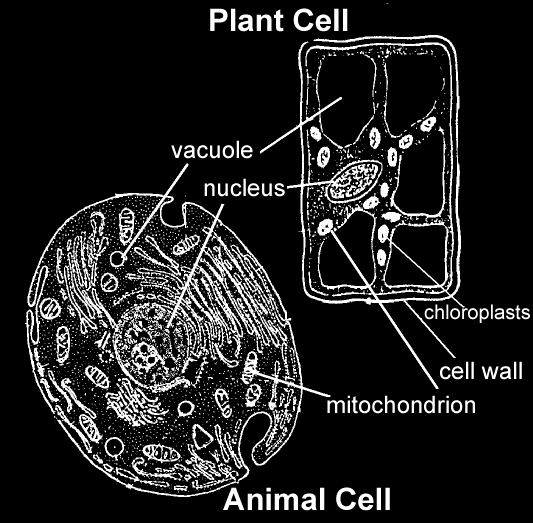
As you can see from the diagram, there are some features found in plant cells but not in animal cells.
Features found in both plant and animal cells:
- Cell surface membrane: This is a partially permeable membrane separating the cell from the environment its made of lipid and protein, it controls movement of substances in and out, its strong but flexible.
- Cytoplasm: This is a jelly like substance, its made of mostly water and protein. Metabolic reactions occur in it.
- Nucleus: This determines how the cell behaves and it contains chromosomes made of strings of DNA which also determines which proteins the cell should make etc.
Features found in only plant cells:
- Cell Wall: This is a rigid layer surrounding the cell made of cellulose, it gives the plant its shape and prevents it from bursting.
- Chloroplasts: They are sacs which contain chlorophyll which is a green pigment that traps sunlight for photosynthesis.
- Vacuole: This is a large room in the center of the cell, it stores sugars and salts and controls movement of water in and out of the cell.
Animal cells store sugars in glycogen form but plant cells store it as starch. Animal cells have an irregular shape but plant cells have a regular shape.
Both types of cells contain Mitochondria these are structures that convert chemical energy in foods to energy that could be used in moving, dividing, etc., it is evidence that the cell is an Active Cell.
Specialised Cells:
Red Blood Cells:
| Red blood cells are found in the blood of animals, its function is to transport oxygen from the lungs to all the body cells, and carbon dioxide from the body cells to the lungs. | 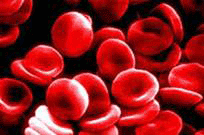 |
They are adapted by four ways:
- They have a biconcave disc shape that gives it a large surface area to carry more oxygen.
- They contain a chemical called hemoglobin that combines with oxygen and carbon dioxide.
- They have no nuclease to carry more oxygen and CO2
- They are tiny enough to squeeze through capillaries.
Muscle Cells:
| They are cells found in muscles in animals, they contract and relax together to move the organisms. Their function is to contract to support and move the body. |
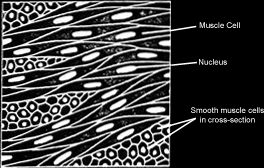 |
They are adapted by two ways, First, Is that they are made of contractile filament to help in contraction. Second is it contains lots of mitochondria to supply the cell with energy.
Ciliated Cells:
Ciliated cells are present in the trachea and bronchi of out respiratory system.
Their function is to use their cilia to move the mucus up the trachea to the throat. The mucus traps bacteria and dust particles. When it reaches the throat, mucus is swallowed to the stomach where the acid kills the bacteria.
| They are adapted by the tiny hair like projections called cilia which sweeps the contaminated mucus upwards. | 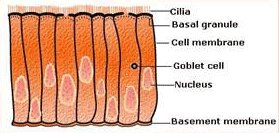 |
The mucus is secreted by goblet cells which are next to ciliated cells.
Root Hair Cells:
These are cells situated in the roots of plants. They contain no chloroplasts. Their function is to absorb water and minerals from the soil. And to anchor the plant in the soil. They are adapted by 3 ways. One, they have an extension that increases the surface area for more water intake. Two, they have a large number of mitochondria for respiration to become more active. Three a concentrated vacuole to help absorbing water by osmosis. |
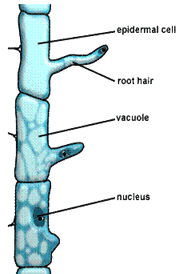 |
Xylem Vessels:
These are dead lignified cells that exist in the stem of a plant.
Their function is to transport water and minerals from the roots to the leaves and the rest of the plant through the stem. And to support the plant.
They are adapted by 2 ways. Firstly, they are hollow to allow water and minerals to pass through them with no resistance. Secondly they are strong and lignified to support the plant.
The Division Of Labour: the specialization of cells to carry out particular functions in an organism.